The alarm rang. At 5:30 in the morning, my mind was still in a murky
haze having arrived in Mrauk U just a few hours before. The entirety of
the previous day was spent traveling by plane, boat and jeep and yet
there I was, up and on the go once more.
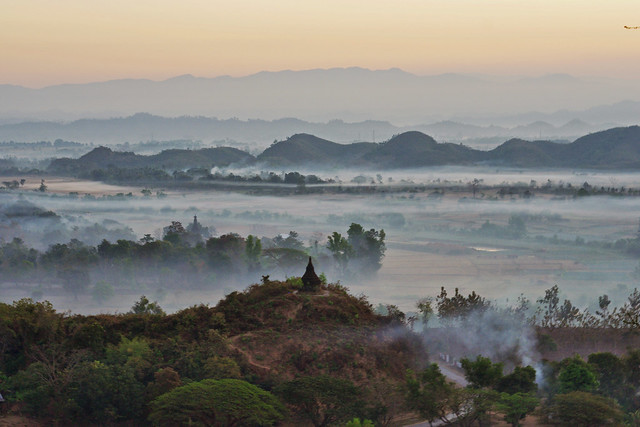 in a dreamlike state…
Burma’s Rakhine state, where Mrauk U is located, is closer to Bangladesh than to Yangon.
The roads here are so underdeveloped that an 80 km road trip between
two points in the state takes almost 5 hours. We decided to take a
longer but less bumpy route, and went on a 6-hour journey by boat after
we arrived in Sittwe, the administrative center of Rakhine state.
in a dreamlike state…
Burma’s Rakhine state, where Mrauk U is located, is closer to Bangladesh than to Yangon.
The roads here are so underdeveloped that an 80 km road trip between
two points in the state takes almost 5 hours. We decided to take a
longer but less bumpy route, and went on a 6-hour journey by boat after
we arrived in Sittwe, the administrative center of Rakhine state.
Sunrise
At 5:30 in the morning, I found myself scaling some unknown peak in utter darkness, with the faint luminance of a flashlight guiding the way. A closer peek revealed a golden pagoda at the top – the Shwetaung Paya, from where the sunrise views of Mrauk U are said to be legendary.
“This better be worth it,” I muttered to myself. The air was a lot colder than what I remembered from when I had arrived. Surely, it wasn’t what I expected for the tropics.
 mrauk u has one of the best sunrises i’ve seen in a long while
By the time we reached the top, the first sign of daybreak had
arrived. I could make out a fog forming in the lower altitudes while the
sky turned dark blue and later into purple. What happened a few minutes
later was perhaps the most magnificent sunrise I have seen in my entire
life. The landscape in Mrauk U in Burma’s restive Rakhaing state at
dawn is a mishmash of cauliflower fields and village huts surrounded by
the morning fog and punctuated by hillocks with several centuries old
stupas – it’s a dreamlike scene made even more apparent by the fact that
I was still only half-awake on this pre-dawn hike.
mrauk u has one of the best sunrises i’ve seen in a long while
By the time we reached the top, the first sign of daybreak had
arrived. I could make out a fog forming in the lower altitudes while the
sky turned dark blue and later into purple. What happened a few minutes
later was perhaps the most magnificent sunrise I have seen in my entire
life. The landscape in Mrauk U in Burma’s restive Rakhaing state at
dawn is a mishmash of cauliflower fields and village huts surrounded by
the morning fog and punctuated by hillocks with several centuries old
stupas – it’s a dreamlike scene made even more apparent by the fact that
I was still only half-awake on this pre-dawn hike.
The sunrise view also served as my orientation to the scattered temples of Mrauk U. There were about 700 in the horizon, and I would only be able to visit a handful.
How to Go to Mrauk U
One of the things that has deterred many travelers and kept Mrauk U mainly off-the-radar despite its ability to give Angkor Wat a run for its money is the long hours involved in getting there. You can basically look at a few ways of getting here, assuming you take a domestic flight with any of the more reliable airlines like Air Mandalay, Yangon Airways or Air KBZ from Yangon to Sittwe, the capital of Rakhine state (around an hour fifteen minutes flight).
By Boat
By far, the most popular method of getting to Mrauk U, it is also one of the longest. You can either take a public ferry which runs every day from Sittwe (similar from the other direction in Mrauk U) at 7AM in the morning. This takes about 6 hours. There is also a fast boat on some days, which takes only 4.5 hours.
Alternatively, you can charter a private boat which can fit up to 4 or 5 people. The boat (including the crew) will basically wait for you for a few days while you’re in Mrauk U and will similarly take you back.
By Car
Despite popular notions on the contrary, it is possible to take a car from Sittwe to Mrauk U. But it is a very bumpy ride. According to the map, Sittwe to Mrauk U by road is a 145 kilometers in distance but the roads are in poor shape so expect the journey to take around 5 hours each way.
Temples of Mrauk U
Later that morning, we started our exploration of the fascinating but little known temples of Mrauk U. As we had only 2 full days to spend in the area, we decided to hire a jeep (a normal car isn’t able to withstand the poor state of the roads) for about $40 a day. Our driver was an amiable chap who spoke decent English and tried his best to offer some stories to the temples we were visiting.
Kothaung Temple
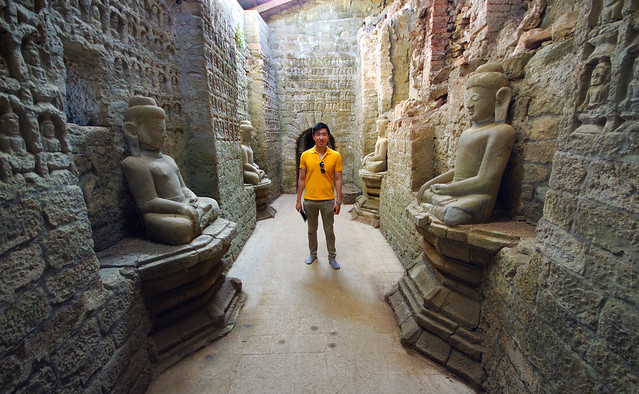 kothaung temple
kothaung temple

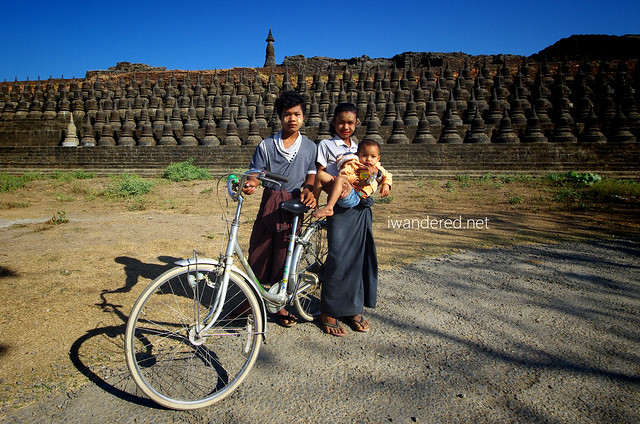 the exterior of kothaung temple – notice the hundreds of stupas
There are a few other interesting temples surrounding Kothaung –
which is one of the farther sites in Mrauk U. The semi-destroyed Pizi Paya for instance, offers a nice hilltop view of the pointy outer shel of Kothaung while Paya Ouk and Mokhong Shwegu served as nice excursions on the way back to town.
the exterior of kothaung temple – notice the hundreds of stupas
There are a few other interesting temples surrounding Kothaung –
which is one of the farther sites in Mrauk U. The semi-destroyed Pizi Paya for instance, offers a nice hilltop view of the pointy outer shel of Kothaung while Paya Ouk and Mokhong Shwegu served as nice excursions on the way back to town.
Sakyamanaung Pagoda & Ratanamanaung Pagoda
 in a dreamlike state…
in a dreamlike state…Sunrise
At 5:30 in the morning, I found myself scaling some unknown peak in utter darkness, with the faint luminance of a flashlight guiding the way. A closer peek revealed a golden pagoda at the top – the Shwetaung Paya, from where the sunrise views of Mrauk U are said to be legendary.
“This better be worth it,” I muttered to myself. The air was a lot colder than what I remembered from when I had arrived. Surely, it wasn’t what I expected for the tropics.
 mrauk u has one of the best sunrises i’ve seen in a long while
mrauk u has one of the best sunrises i’ve seen in a long whileThe sunrise view also served as my orientation to the scattered temples of Mrauk U. There were about 700 in the horizon, and I would only be able to visit a handful.
How to Go to Mrauk U
One of the things that has deterred many travelers and kept Mrauk U mainly off-the-radar despite its ability to give Angkor Wat a run for its money is the long hours involved in getting there. You can basically look at a few ways of getting here, assuming you take a domestic flight with any of the more reliable airlines like Air Mandalay, Yangon Airways or Air KBZ from Yangon to Sittwe, the capital of Rakhine state (around an hour fifteen minutes flight).
By Boat
By far, the most popular method of getting to Mrauk U, it is also one of the longest. You can either take a public ferry which runs every day from Sittwe (similar from the other direction in Mrauk U) at 7AM in the morning. This takes about 6 hours. There is also a fast boat on some days, which takes only 4.5 hours.
Alternatively, you can charter a private boat which can fit up to 4 or 5 people. The boat (including the crew) will basically wait for you for a few days while you’re in Mrauk U and will similarly take you back.
By Car
Despite popular notions on the contrary, it is possible to take a car from Sittwe to Mrauk U. But it is a very bumpy ride. According to the map, Sittwe to Mrauk U by road is a 145 kilometers in distance but the roads are in poor shape so expect the journey to take around 5 hours each way.
Temples of Mrauk U
Later that morning, we started our exploration of the fascinating but little known temples of Mrauk U. As we had only 2 full days to spend in the area, we decided to hire a jeep (a normal car isn’t able to withstand the poor state of the roads) for about $40 a day. Our driver was an amiable chap who spoke decent English and tried his best to offer some stories to the temples we were visiting.
Kothaung Temple
 kothaung temple
kothaung temple
We started our exploration at the temple of 90,000 Buddha images or otherwise known as Kothaung temple.
To have started here was pretty symbolic. If there was anything that
drove me to insanely pursue such a long trip to get to a remote place
like Mrauk U, it was the sight of this square-shaped edifice. From the
outside, its large size and cube-like construction gave off a faint
reminder of Borobudur in Central Java. The exteriors are replete with
hundreds if not thousands of small stupas that give Kothaung a bit of a
pointy / thorny look. The inner chambers on the other hand reveal almost
life-sized Buddha statues on both sides of the wall. I reckoned the
gray monotone construction and exotic looking statues would make the
temple a shoo-in if there is ever a need to scout filming locations for
the next Indiana Jones movie. The place was just sublime.

 the exterior of kothaung temple – notice the hundreds of stupas
the exterior of kothaung temple – notice the hundreds of stupas Sakyamanaung Pagoda & Ratanamanaung Pagoda
 the relatively understated sakyamanaung stupa
the relatively understated sakyamanaung stupaRatanamanaung, which is about half a mile away, had a similar design though it also had a more modern construction next to it with a large Buddha statue and an unassuming souvenir shop.
Ratanabon Pagoda and Andaw Pagoda
 5 of the 24 small stupas surrounding a large central one in ratanabon pagoda
5 of the 24 small stupas surrounding a large central one in ratanabon pagodaA few feet away from Ratanabon Pagoda is the Andaw Pagoda. Like Ratanabon, there are numerous stupas surrounding a central one but the difference here is that all of them are roughly of the same size. There is also an interesting inner chamber at the main stupa with a handful Buddha statues inside. However, it was pitch black when we entered and we couldn’t see a thing.
Shitte-thaung Temple
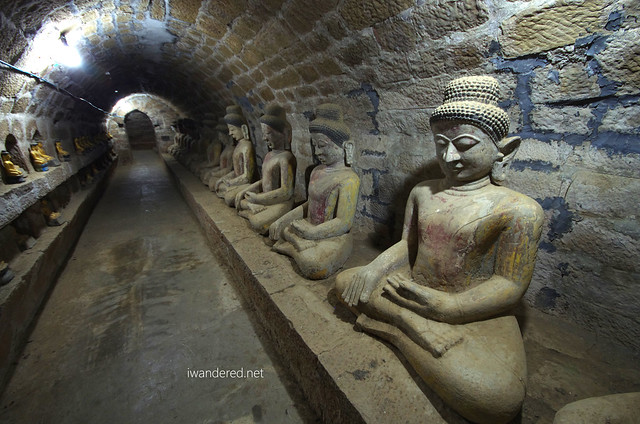
 scenes inside the shitte-thaung temple, the second photo has lots of depictions of life in medieval mrauk u
scenes inside the shitte-thaung temple, the second photo has lots of depictions of life in medieval mrauk u
Widely recognized as the “main temple” of Mrauk U, the Shitte-thaung Temple
is where most visitors start in Mrauk U. The $5 zone fee is collected
here. When I stopped by the temple, I scanned the log book for the
visitor profiles. Not a single Filipino it seemed, visited in the 2 or 3
months before I did. When I asked the guy at the registration, I was
told that I was the first Filipino tourist he had seen around Mrauk U.
The log book didn’t reveal many visitors from Southeast Asia either.
Around 1 or 2 other Singaporeans, Malaysians and Indonesians; a couple
of Thais and that was about it for the past 2 or 3 months. I wasn’t
really sure how I was going to react to the guard’s assertion – the
brief thought that I may be the only Filipino insane enough to come
briefly popped up, but was quickly quelled by the fact that I was
enjoying what I was seeing so far.
Of the temples in the entire archeological site, Shitte-thaung
probably ranks as my second favorite. The temple itself is divided
between a newer and older part. The older part consists of the
passageways that run through the temple’s perimeter. Within it, I saw
more Buddha statues in stone – though these weren’t as exotic looking as
the ones I saw in Kothaung. But apart from that, there were fascinating
carvings depicting daily life as well as royal life in the outer
passageway. The sheer number of objects in the wall carving as well as
the level of detail were very impressive and there’s a walkway from
which one can have a great view of a bunker-looking temple down the
hill.
Htukkanthein Temple the bunker temple of htukkanthein
the bunker temple of htukkantheinThere was a great deal of speculation by the British as to why the temple look the way it does. There were some theories that claimed that the temple doubled as a shelter during times of war. Or that the hard outer shell helped to protect the structure against the fierce winds of Arakan. But I guess we’ll never really know.
Laymyatna Pagoda
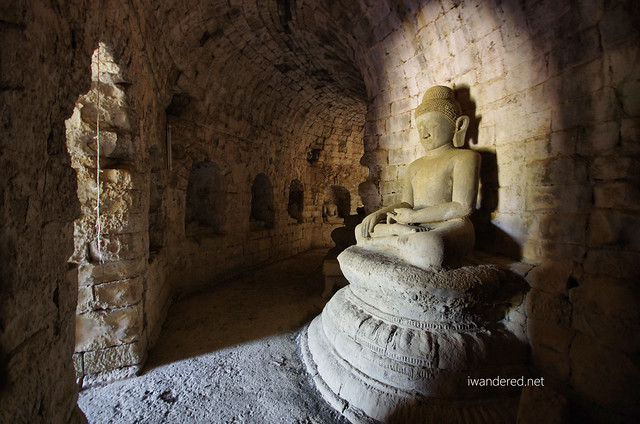 natural light on the Buddha
natural light on the BuddhaOther Temples
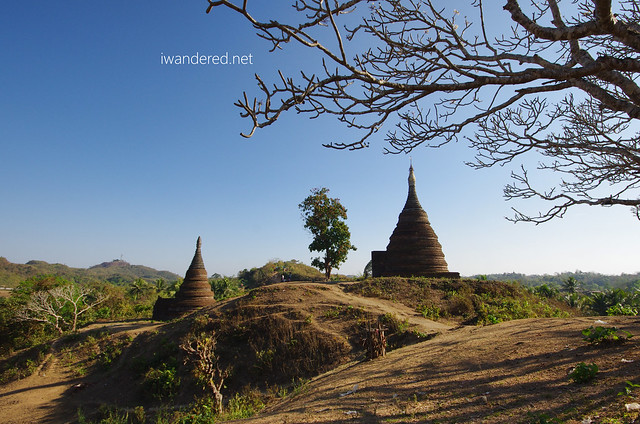 some of the other temples around mrauk u
some of the other temples around mrauk uSunrise & Sunset Views
The sunrise and sunset views around Mrauk U alone are worth the long trip to get here. Aside from the classic Shwethaung Pagoda sunrise on my first day, I also ventured to a place called Discovery View (fee of 500 kyats) just north of Ratanabon Pagoda and the hilltop temples of U-mrawa and Haridaung close to town. Here’s a peek of the views from up there:
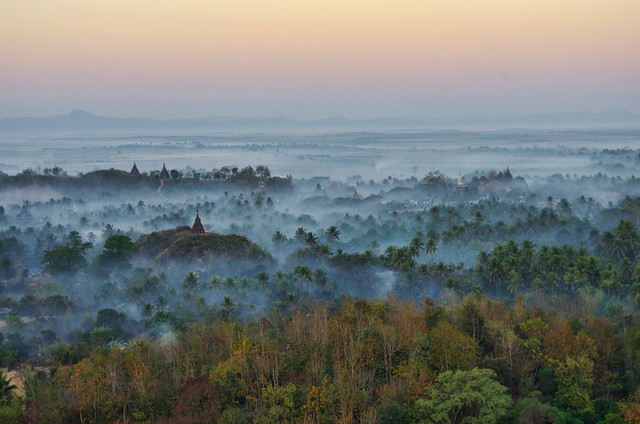 morning mist – it was a cool 13 celsius in the mornings but quickly rose to a sweltering 35 by noon
morning mist – it was a cool 13 celsius in the mornings but quickly rose to a sweltering 35 by noon just gorgeous!
just gorgeous!
Where I Stayed
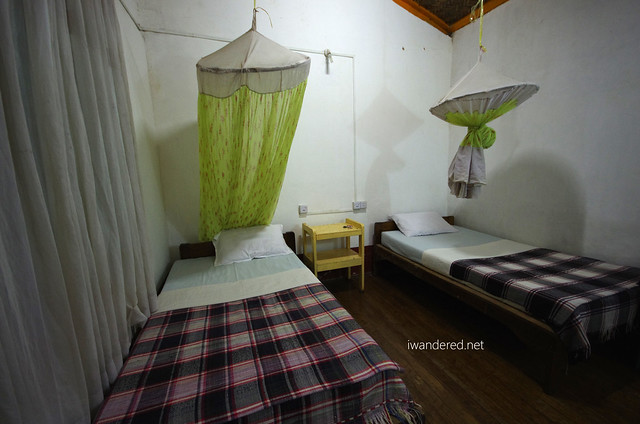 the $25 a night room at prince hotel
the $25 a night room at prince hotel
I stayed at a humble little place called Prince Hotel.
Rooms were about US$ 25 a night. The owners here are mighty proud to
have built the very first hotel in Mrauk U. Very simple accommodation
run by a family and the owners are quite knowledgeable regarding the
area. Service is excellent. I like how they would invite us to sit by
the dining table every night to to help us sort out the following day’s
plans. They also arrange boat trips to remote Chin villages for a decent
price.
Tips for Mrauk U
- Avoid coming during the rainy season from mid-May to September. In Mrauk U. When it rains, it pours!
- The best time to visit Mrauk U is from November to mid-March when it’s cooler in the mornings and you get to see the morning mist
- Put at least a 1 day allowance to your trip to cater for possible ferry or flight cancellations. It’s pretty common over at these parts
- Bring lots of insect repellent. You’ll be thankful you did.
- Myanmar has one of the highest incidences of malaria in Southeast Asia and Mrauk U is considered to be more frontier than Bagan or Inle Lake. While it may still be okay to visit without having taken malaria pills, it’s best to wear long-sleeve shirts and pants to decrease the chances of getting the disease.
- Change your kyats beforehand. Avoid changing in Mrauk U. The exchange rate here is very bad.
Day 1
Sunrise: Shwetaung Paya
East Group (Kothaung, Pizi Paya, Mong Khong Pagoda)
Central (Shitte-thaung, Ratanabon, Andaw, Ratamanaung, Sakyamanaung)
North (Mahabodhi Shwegu, Laungbwanbyauk, Httuparon)
Sunset: Discovery View
Day 2
Sunrise: U-mrawa Paya
Chin Village Excursion
-or-
Excursion to Vesali and Mahamuni
Ref: http://iwandered.net/2014/03/12/temples-of-mrauk-u-burma-myanmar/

Comments